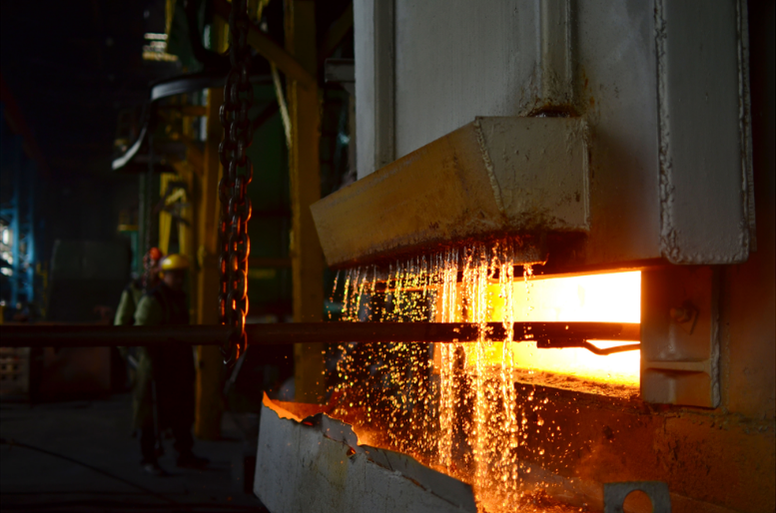
At Obersan, we perform critical heat treatment processes such as hardening, annealing, normalization, and stress relieving with our internationally certified suppliers. This ensures that parts achieve the desired hardness and strength values after machining. Parts of various sizes are meticulously heat-treated according to stringent standards, providing reliable and repeatable results. Heat treatment is a controlled process that alters the microstructure of metals and alloys, enhancing properties such as surface hardness, temperature resistance, ductility, and durability, thus extending the service life of the parts. The primary heat treatment processes we offer solutions for include:
Neutral hardening is a heat treatment method applied to metal materials, especially steels, to achieve the desired hardness level. This process is carried out in a controlled atmosphere to prevent carbon or nitrogen loss on the material’s surface.
Applications:
- Carbon steels
- Alloy steels
- Stainless steels
Advantages:
- Ideal strength values can be achieved to provide high durability and toughness resistance in parts exposed to heavy loads.
- Parts become lighter and stronger due to higher durability, and tools and molds can have high wear and/or high heat resistance while maintaining toughness levels.
- Increases the machinability of parts that require grinding to reduce roughness.
· For martensitic stainless steel parts, corrosion resistance is only achieved after heat treatment.
Tempering is a heat treatment method applied to materials, especially steels, to achieve specific hardness and toughness levels. This process is performed at low temperatures and is applied after various hardening methods. Tempering enhances the mechanical properties of the material, achieving the desired hardness and toughness values.
Application Methods:
- Neutral hardening
- Double hardening
- Gas carburizing
- Carbonitriding
- Induction hardening
Advantages:
- Increases toughness by reducing the hardness of steel.
Brings the hardness/toughness ratio of the material to the desired level.
Annealing is a heat treatment method aimed at improving the microstructure of metal materials, relieving internal stresses, and facilitating machining and processing. This process involves heating the material to a specific temperature and then cooling it in a controlled manner.
Advantages:
- Reduces internal stresses formed during machining, hot and cold forming processes, resulting in a homogeneous microstructure.
- Makes the material more ductile by reducing its tensile strength.
- Facilitates machining processes by making the workpiece easier to machine.
Materials:
- Carbon steels
- Alloy steels
Copper and its alloys
Normalization is a heat treatment method aimed at homogenizing the microstructure of metal materials and obtaining a finer grain structure.
Advantages:
- Reduces internal stresses formed after hot and cold forging, rolling, casting, and machining processes, allowing for a homogeneous microstructure.
- Minimizes unwanted dimensional distortions by reducing internal stresses formed after machining and welding processes, ensuring dimensional stability.
Materials:
- Carbon steels
- Alloy steels
· Cast steels
Stress relieving is a heat treatment method aimed at minimizing residual stresses in the structure of the part, reducing the risk of dimensional changes that may occur during production stages or final use.
Advantages:
- Stress Reduction: Applied to minimize stresses and the risk of dimensional distortion caused by machining, plastic forming, or welding processes.
- Critical Stages: Typically performed after rough machining and before final machining, such as polishing or grinding.
- High-Tolerance Parts: Applied before processes such as nitrocarburizing for parts with tight tolerances and advanced processing.
Materials:
- Steel alloys
Copper and brass alloys
Nitriding is a widely used heat treatment process for surface hardening of steels. This process enhances the performance and service life of materials by providing high surface hardness and wear resistance. Nitriding is a heat treatment method that increases surface hardness by diffusing nitrogen into the metal surface. This process is typically carried out at low temperatures (500-550°C) and is generally a long-term process. During nitriding, nitrogen penetrates the metal surface, forming a hard nitride layer.
Benefits:
- Enhances wear and corrosion resistance by increasing surface hardness, significantly improving the performance and durability of parts.
- The high hardness increases the wear resistance of the surface, allowing parts to last longer.
Nitriding is performed at lower temperatures than other surface hardening processes, maintaining dimensional stability and reducing the risk of deformation.
Nitrocarburizing is a heat treatment method that increases surface hardness by diffusing both nitrogen and carbon into the metal surface.
Process:
- Carried out at temperatures between 500-600°C.
- Typically performed in a gas environment or salt bath.
- Nitrogen and carbon diffuse into the metal surface, forming a hard compound layer.
Advantages:
- Provides good wear and corrosion resistance.
- The process is carried out at low temperatures, causing minimal distortion to the material.
- Creates a thinner and more homogeneous hardness layer.
Applications:
Parts requiring wear resistance, such as gears, shafts, and bearings.
Carburizing is a heat treatment method that increases surface hardness by diffusing carbon into the metal surface.
Process:
- Carried out at temperatures between 850-950°C.
- Typically performed in a gas environment, solid carbon source, or liquid bath.
- Carbon diffuses into the metal surface, forming a hard carbon layer.
- After carburizing, the part is usually rapidly cooled (quenched) in water or oil.
Benefits:
- Provides high surface hardness.
- Creates a deeper hardened surface layer through deep carburizing.
- Provides good wear resistance.
Applications:
Used for surface hardening of heavy load-bearing parts such as gears, chain links, bearings, shafts, and axles.
